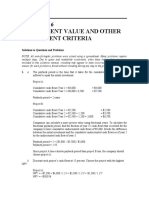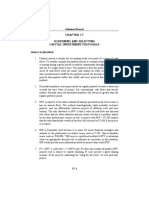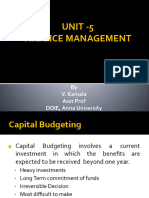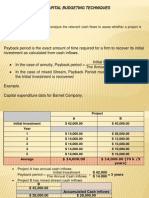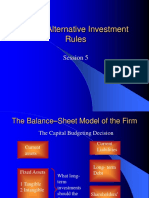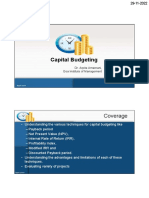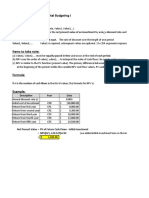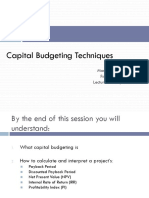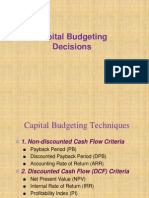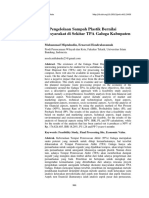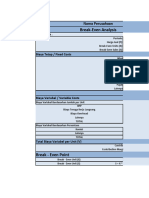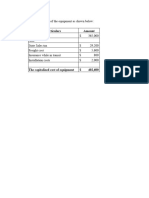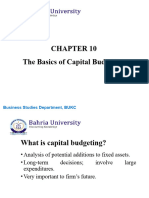Chapter 9 Questions:
Project A
Cash flows of 23,000 and 28,000 in years 1 and 2, so the flows are short of 60,000 by 9,000.
Time to payback is: 2 + (9000/21000) = 2.43 years (Meets the 3 year payback criteria so accept).
Project B:
Cash flows of 15, 18 and 26K = 59 K total still short of 70K by 11K after year 3 so reject the project.
Time to payback = 3 + 11/230 = 3.05 years
When we use discounted payback, we need to find the value of all cash flows today.
The value today of the project cash flows for the first four years is:
Formula = Cash flow/(1 + discount rate)t
Value today of Year 1 cash flow = $4,200/1.14 = $3,684.21
Value today of Year 2 cash flow = $5,300/1.142 = $4,078.18
Value today of Year 3 cash flow = $6,100/1.143 = $4117.33
Value today of Year 4 cash flow = $7,400/1.144 = $4381.39
To find the discounted payback, we use these values to find the payback period. The discounted first
year cash flow is $3,684.21, so the discounted payback for an $7,000 initial cost is:
Formula:
Discounted payback = Years until breakeven + (unrecovered amt) or (initial – cash flow amt)/recovery
year cash flow
�Discounted payback = 1 + ($7,000 – 3,684.21)/$4,078.18 = 1.813 years
For an initial cost of $10,000, the discounted payback is:
Discounted payback = Years until breakeven + (unrecovered amt) or (initial – cash flow amts)/recovery
year cash flow
Discounted payback = 2 + ($10,000 – 3,684.21– 4,078.18)/$4,117.33 = 2.54 years
2 because looking at payback we can see we will hit 10K between years 2 and 3.
Notice the calculation of discounted payback. We know the payback period is between two and three
years, so we subtract the discounted values of the Year 1 and Year 2 cash flows from the initial cost.
This is the numerator, which is the discounted amount we still need to make to recover our initial
investment. We divide this amount by the discounted amount we will earn in Year 3 to get the
fractional portion of the discounted payback.
If the initial cost is $13,000, the discounted payback is:
Discounted payback = Years until breakeven + (unrecovered amt) or (initial – cash flow amts)/recovery
year cash flow
Discounted payback = 3 + ($13,000 – 3684.21 – 4078.18 – 4117.33) / $4,381.39 = 3.26 years
Our definition of AAR is the average net income divided by the average book value.
AAR = Average net income / Average book value
The average net income for this project is:
Average net income = ($1,854,300 + 1,907,600 + 1,876,000 + 1,329,500) / 4 = $1,741,850
And the average book value is:
Average book value = (Value at Start of Project + Value at End of Project/2)
Average book value = ($12,000,000 + 0) / 2 = $6,000,000
So, the AAR for this project is:
AAR = Average net income / Average book value = $1,741,850 / $6,000,000 = .2903, or 29.03%
�The NPV of a project is the PV of the outflows minus the PV of the inflows.
Since the cash inflows are an annuity, the equation for the NPV of this project at an 8 percent required
return is:
NPV = - PMT + Cash Flow (PVIFA)
PVIFA = (1- (1+ r)-n/r)
NPV = –$78,000 + $17,300(1- (1+ 0.08)-9/0.08) = $30,071.16
At an 8 percent required return, the NPV is positive, so we would accept the project.
The equation for the NPV of the project at a 20 percent required return is:
NPV = –$78,000 + $17,300(PVIFA20%, 9) = –$8,264.28
At a 20 percent required return, the NPV is negative, so we would reject the project.
We would be indifferent to the project if the required return was equal to the IRR of the project, since
at that required return the NPV is zero. The IRR of the project is:
Set IRR to 0
0 = –$78,000 + $17,300(PVIFAIRR, 9)
IRR = 16.62%
Question 15.
The profitability index is defined as the PV of the cash inflows divided by the PV of the cash outflows.
The equation for the profitability index at a required return of 10 percent is:
PI = [sum of Cash Flows/1+rn]/Initial Investment
�PI = [$7,300/1.1 + $6,900/1.12 + $5,700/1.13] / $14,000 = 1.187
The equation for the profitability index at a required return of 15 percent is:
PI = [$7,300/1.15 + $6,900/1.152 + $5,700/1.153] / $14,000 = 1.094
The equation for the profitability index at a required return of 22 percent is:
PI = [$7,300/1.22 + $6,900/1.222 + $5,700/1.223] / $14,000 = 0.983
We would accept the project if the required return were 10 percent or 15 percent since the PI is
greater than one. We would reject the project if the required return were 22 percent since the PI is
less than one.
Solution:
The payback period for each project is:
A: Payback = Years until breakeven + (unrecovered amt) or (initial – cash flow amts)/recovery year
cash flow
= 3 + ($175,000/$440,000) = 3.40 years
B: Payback = Years until breakeven + (unrecovered amt) or (initial – cash flow amts)/recovery year
cash flow
�= 2 + ($4,000/$19,500) = 2.21 years
The payback criterion implies accepting project B, because it pays back sooner than project A.
b. The discounted payback for each project is:
Sum of discounted cash flows/1+rt
A: $45,000/1.15 + $65,000/1.152 + $65,000/1.153 = $131,018.33
$440,000/1.154 = $251,571.43 – Have to discount last year too
Discounted payback = Years until breakeven + (unrecovered amt) or (initial – discounted cash flow
amt)/recovery year cash flow
Discounted payback = 3 + ($350,000 – 131,018.33)/$251,571.43 = 3.87 years
B: Sum of discounted cash flows/1+rt
$24,000/1.15 + $22,000/1.152 = $37,504.73
$19,500/1.153 = $12,821.57 Have to discount last year too
Discounted payback = Years until breakeven + (unrecovered amt) or (initial – discounted cash flow
amt)/recovery year cash flow
Discounted payback = 2 + ($50,000 – 37,504.73)/$12,821.57 = 2.97 years
The discounted payback criterion implies accepting project B because it pays back sooner than A.
c. The NPV for each project is:
NPV = - Initial investment + Cash Flow 1/(1 +r)1 + Cash Flow 2/(1 +r)2 + …..
A: NPV = –$350,000 + $45,000/1.15 + $65,000/1.152 + $65,000/1.153 + $440,000/1.154
NPV = $32,589.76
B: NPV = –$50,000 + $24,000/1.15 + $22,000/1.152 + $19,500/1.153 + $14,600/1.154
NPV = $8,673.89
NPV criterion implies we accept project A because project A has a higher NPV than project B.
d. The IRR for each project is:
To find IRR:
Set NPV to Investment or 350K for A:
NPV = - Initial investment + Cash Flow 1/(1 +r)1 + Cash Flow 2/(1 +r)2 + …..
A: $350,000 = $45,000/(1+IRR) + $65,000/(1+IRR)2 + $65,000/(1+IRR)3 + $440,000/(1+IRR)4
Using a spreadsheet, financial calculator, or trial and error to find the root of the equation, we
�find that:
IRR = 18.14%
To find IRR:
Set NPV to Investment or 350K for A:
NPV = - Initial investment + Cash Flow 1/(1 +r)1 + Cash Flow 2/(1 +r)2 + …..
B: $50,000 = $24,000/(1+IRR) + $22,000/(1+IRR)2 + $19,500/(1+IRR)3 + $14,600/(1+IRR)4
Using a spreadsheet, financial calculator, or trial and error to find the root of the equation,
we find that:
IRR = 24.08%
IRR decision rule implies we accept project B because IRR for B is greater than IRR for A.
e. The profitability index for each project is:
PI = Cash Flow 1/(1 +r)1 + Cash Flow 2/(1 +r)2 + …../Initial Investment
A: PI = ($45,000/1.15 + $65,000/1.152 + $65,000/1.153 + $440,000/1.154) / $350,000 = 1.093
B: PI = ($24,000/1.15 + $22,000/1.152 + $19,500/1.153 + $14,600/1.154) / $50,000 = 1.173
Profitability index criterion implies accept project B because its PI is greater than project A’s.
f. In this instance, the NPV criteria implies that you should accept project A, while profitability index,
payback period, discounted payback, and IRR imply that you should accept project B. The final
decision should be based on the NPV since it does not have the ranking problem associated with
the other capital budgeting techniques. Therefore, you should accept project A.
�The IRR of the project is:
To find IRR:
Set NPV to Investment or 58K:
NPV = - Initial investment + Cash Flow 1/(1 +r)1 + Cash Flow 2/(1 +r)2 + …..
$58,000 = -$34,000/(1+IRR) + $45,000/(1+IRR)2
Using a spreadsheet, financial calculator, or trial and error to find the root of the equation, we find
that:
IRR = 22.14%
At an interest rate of 12 percent, the NPV is:
- Initial investment + Cash Flow 1/(1 +r)1 + Cash Flow 2/(1 +r)2 + …..
NPV = - $58,000 + $34,000/1.12 + $45,000/1.122
NPV = –$8,230.87
At an interest rate of zero percent, we can add cash flows, so the NPV is:
NPV = -$58,000 + $34,000 + $45,000
NPV = –$21,000.00
And at an interest rate of 24 percent, the NPV is:
NPV = - $58,000 + $34,000/1.24 + $45,000/1.242
NPV = +$1,314.26
The cash flows for the project are unconventional. Since the initial cash flow is positive and the
remaining cash flows are negative, the decision rule for IRR in invalid in this case. The NPV profile is
upward sloping, indicating that the project is more valuable when the interest rate increases.


